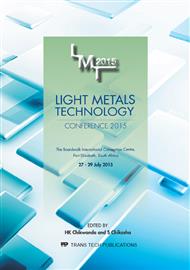[1]
T. Kawasaki T. Makino K. Masai H. Ohba Y. Ina M. Ezumi, Application of friction stir welding to construction of railway vehicles. JSME International Journal Series A. 47(3) (2004) 502-511.
DOI: 10.1299/jsmea.47.502
Google Scholar
[2]
D. Rodrigues C. Leitao, R. Louro, H. Gouveia, A. Loureiro, High speed friction stir welding of aluminium alloys. Science and Technology of Welding and Joining. 15(8) (2010) 676-681.
DOI: 10.1179/136217110x12785889550181
Google Scholar
[3]
J. Defalco, Friction stir welding vs. fusion welding. Energy. 1 (2006) 3.
Google Scholar
[4]
K. Deplus A. Simar W. Haver B. Meester, Residual stresses in aluminium alloy friction stir welds. Int. J. Adv. Manuf. Technol. 56(5-8) (2011) 493-504. English.
DOI: 10.1007/s00170-011-3210-0
Google Scholar
[5]
D. Rao, J. Heerens, G. Alves Pinheiro, J.F. dos Santos, N. Huber. On characterisation of local stress–strain properties in friction stir welded aluminium AA 5083 sheets using micro-tensile specimen testing and instrumented indentation technique. Materials Science and Engineering: A. 527(18–19) (2010).
DOI: 10.1016/j.msea.2010.04.047
Google Scholar
[6]
A.K. Lakshminarayanan, S. Malarvizhi, V. Balasubramanian. Developing friction stir welding window for AA2219 aluminium alloy. Transactions of Nonferrous Metals Society of China. 21(11) (2011) 2339-2347.
DOI: 10.1016/s1003-6326(11)61018-2
Google Scholar
[7]
L. Commin, M. Dumont, J.F. Masse, L. Barrallier. Friction stir welding of AZ31 magnesium alloy rolled sheets: Influence of processing parameters. Acta Materialia. 57(2) (2009) 326-334.
DOI: 10.1016/j.actamat.2008.09.011
Google Scholar
[8]
T. Ishikawa, H. Fujii, K. Genchi, S. Iwaki, S. Matsuoka, K. Nogi. High speed-high quality friction stir welding of austenitic stainless steel. ISIJ international. 49(6) (2009) 897-901.
DOI: 10.2355/isijinternational.49.897
Google Scholar
[9]
C. Leitão, R. Louro, D.M. Rodrigues. Using torque sensitivity analysis in accessing Friction Stir Welding/Processing conditions. Journal of Materials Processing Technology. 212(10) (2012) 2051-(2057).
DOI: 10.1016/j.jmatprotec.2012.05.009
Google Scholar
[10]
A. Oosterkamp, L.D. Oosterkamp, A. Nordeide. Kissing bond phenomena in solid-state welds of aluminum alloys. WELDING JOURNAL-NEW YORK-. 83(8) (2004) 225-S.
Google Scholar
[11]
Y.S. Sato, H. Takauchi, S.H.C. Park, H. Kokawa. Characteristics of the kissing-bond in friction stir welded Al alloy 1050. Materials Science and Engineering: A. 405(1–2) (2005) 333-338.
DOI: 10.1016/j.msea.2005.06.008
Google Scholar
[12]
M. Peel, A. Steuwer, P. Withers, T. Dickerson, Q. Shi, H. Shercliff. Dissimilar friction stir welds in AA5083-AA6082. Part I: process parameter effects on thermal history and weld properties. Metallurgical and Materials Transactions A. 37(7) (2006).
DOI: 10.1007/bf02586138
Google Scholar


